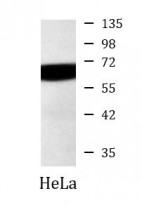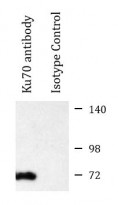ARG54158
anti-Ku 70 antibody
anti-Ku 70 antibody for ICC/IF,Immunoprecipitation,Western blot and Human,Monkey
Cancer antibody; Gene Regulation antibody
Overview
| Product Description | Mouse Monoclonal antibody recognizes Ku 70 |
|---|---|
| Tested Reactivity | Hu, Mk |
| Tested Application | ICC/IF, IP, WB |
| Host | Mouse |
| Clonality | Monoclonal |
| Isotype | IgG1 |
| Target Name | Ku 70 |
| Antigen Species | Human |
| Immunogen | Purified recombinant human Ku70 protein fragments expressed in E.coli. |
| Conjugation | Un-conjugated |
| Alternate Names | DNA repair protein XRCC6; Thyroid-lupus autoantigen; Lupus Ku autoantigen protein p70; EC 4.2.99.-; EC 3.6.4.-; ATP-dependent DNA helicase II 70 kDa subunit; X-ray repair complementing defective repair in Chinese hamster cells 6; CTC box-binding factor 75 kDa subunit; 70 kDa subunit of Ku antigen; CTC75; 5'-deoxyribose-5-phosphate lyase Ku70; KU70; TLAA; 5'-dRP lyase Ku70; CTCBF; ML8; G22P1; X-ray repair cross-complementing protein 6; ATP-dependent DNA helicase 2 subunit 1; Ku70 |
Application Instructions
| Application Suggestion |
|
||||||||
|---|---|---|---|---|---|---|---|---|---|
| Application Note | * The dilutions indicate recommended starting dilutions and the optimal dilutions or concentrations should be determined by the scientist. | ||||||||
| Observed Size | 67 kDa |
Properties
| Form | Liquid |
|---|---|
| Purification | Affinity purified |
| Buffer | PBS (pH 7.4), 0.02% Sodium azide and 50% Glycerol |
| Preservative | 0.02% Sodium azide |
| Stabilizer | 50% Glycerol |
| Concentration | 1 mg/ml |
| Storage Instruction | For continuous use, store undiluted antibody at 2-8°C for up to a week. For long-term storage, aliquot and store at -20°C. Storage in frost free freezers is not recommended. Avoid repeated freeze/thaw cycles. Suggest spin the vial prior to opening. The antibody solution should be gently mixed before use. |
| Note | For laboratory research only, not for drug, diagnostic or other use. |
Bioinformation
| Database Links |
Swiss-port # P12956 Human X-ray repair cross-complementing protein 6 |
|---|---|
| Gene Symbol | XRCC6 |
| Gene Full Name | X-ray repair complementing defective repair in Chinese hamster cells 6 |
| Background | Single-stranded DNA-dependent ATP-dependent helicase. Has a role in chromosome translocation. The DNA helicase II complex binds preferentially to fork-like ends of double-stranded DNA in a cell cycle-dependent manner. It works in the 3'-5' direction. Binding to DNA may be mediated by XRCC6. Involved in DNA non-homologous end joining (NHEJ) required for double-strand break repair and V(D)J recombination. The XRCC5/6 dimer acts as regulatory subunit of the DNA-dependent protein kinase complex DNA-PK by increasing the affinity of the catalytic subunit PRKDC to DNA by 100-fold. The XRCC5/6 dimer is probably involved in stabilizing broken DNA ends and bringing them together. The assembly of the DNA-PK complex to DNA ends is required for the NHEJ ligation step. Required for osteocalcin gene expression. Probably also acts as a 5'-deoxyribose-5-phosphate lyase (5'-dRP lyase), by catalyzing the beta-elimination of the 5' deoxyribose-5-phosphate at an abasic site near double-strand breaks. 5'-dRP lyase activity allows to 'clean' the termini of abasic sites, a class of nucleotide damage commonly associated with strand breaks, before such broken ends can be joined. The XRCC5/6 dimer together with APEX1 acts as a negative regulator of transcription. |
| Function | Single-stranded DNA-dependent ATP-dependent helicase. Has a role in chromosome translocation. The DNA helicase II complex binds preferentially to fork-like ends of double-stranded DNA in a cell cycle-dependent manner. It works in the 3'-5' direction. Binding to DNA may be mediated by XRCC6. Involved in DNA non-homologous end joining (NHEJ) required for double-strand break repair and V(D)J recombination. The XRCC5/6 dimer acts as regulatory subunit of the DNA-dependent protein kinase complex DNA-PK by increasing the affinity of the catalytic subunit PRKDC to DNA by 100-fold. The XRCC5/6 dimer is probably involved in stabilizing broken DNA ends and bringing them together. The assembly of the DNA-PK complex to DNA ends is required for the NHEJ ligation step. Required for osteocalcin gene expression. Probably also acts as a 5'-deoxyribose-5-phosphate lyase (5'-dRP lyase), by catalyzing the beta-elimination of the 5' deoxyribose-5-phosphate at an abasic site near double-strand breaks. 5'-dRP lyase activity allows to 'clean' the termini of abasic sites, a class of nucleotide damage commonly associated with strand breaks, before such broken ends can be joined. The XRCC5/6 dimer together with APEX1 acts as a negative regulator of transcription. [UniProt] |
| Cellular Localization | Nucleus. Chromosome |
| Research Area | Cancer antibody; Gene Regulation antibody |
| Calculated MW | 70 kDa |
| PTM | Phosphorylation by PRKDC may enhance helicase activity. Phosphorylation of Ser-51 does not affect DNA repair. |
Images (3) Click the Picture to Zoom In
-
ARG54158 anti-Ku 70 antibody ICC/IF image
Immunofluorescence: HeLa cells fixed with -20°C Methanol and stained with ARG54158 anti-Ku 70 antibody at 1:200 dilution.
-
ARG54158 anti-Ku 70 antibody WB image
Western blot: HeLa cell lysate stained with ARG54158 anti-Ku 70 antibody at 1:1000 dilution.
-
ARG54158 anti-Ku 70 antibody IP image
Immunoprecipitation: HeLa cell lysates were immunoprecipitated and stained with ARG54158 anti-Ku 70 antibody.
Specific References










